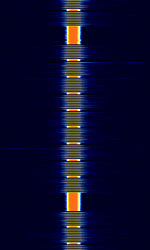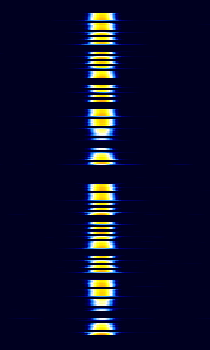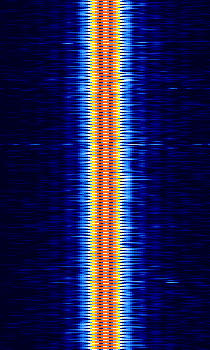Beta
From Signal Identification Wiki
Beta is the designation of a Russian VLFVery Low Frequency (3-30 kHz) time signal service, controlled by All-Russian Scientific Research Institute for Physical-Engineering and Radiotechnical Metrology, and operated by Russian Navy. It is transmitted several times per day from 6 transmitter stations which take turns transmitting the signal and only one station transmits at a time.
The six Beta transmitters are: [1][2]
- RJH63, Krasnodar, Russia
- RJH69, Vilyeyka, near Molodechno, Belarus
- RJH77, Archangelsk, Russia
- RJH86, Bishkek, Kyrgyzstan
- RJH90, Nizhny Novgorod, Russia
- RAB99, Khabarovsk, Russia
Transmission schedule[edit]
Beta transmissions start on the hour and 8 transmissions [1] should happen every day. RJH63 and RAB99 use slightly different schedule compared to the other stations.
| Frequency | Minutes | Signal | |
|---|---|---|---|
| Start | Duration | ||
| 25.0 kHzKiloHertz (kHz) 10^3 Hz | :00 | 1 | Transmitter tune-up, low-power unmodulated carrier |
| :01 | 5 | Unmodulated carrier | |
| :06 | 1 | Morse code call sign, on-off keying | |
| :07 | 3 | Unmodulated carrier | |
| :10 | 3 | On-off modulated with 40 HzHertz (Hz), unit of frequency, defined as one cycle per second (1 Hz). square wave | |
| :13 | 9 | Time code, on-off modulation | |
| :22 | 3 | On-off modulated with 40 HzHertz (Hz), unit of frequency, defined as one cycle per second (1 Hz). square wave | |
| 25.1 kHzKiloHertz (kHz) 10^3 Hz | :25 | 1 | Transmitter tune-up, low-power unmodulated carrier |
| :26 | 4 | Unmodulated carrier | |
| 25.5 kHzKiloHertz (kHz) 10^3 Hz | :30 | 1 | Transmitter tune-up, low-power unmodulated carrier |
| :31 | 4 | Unmodulated carrier | |
| 23.0 kHzKiloHertz (kHz) 10^3 Hz | :35 | 1 | Transmitter tune-up, low-power unmodulated carrier |
| :36 | 5 | Unmodulated carrier | |
| 20.5 kHzKiloHertz (kHz) 10^3 Hz | :41 | 1 | Transmitter tune-up, low-power unmodulated carrier |
| :42 | 5 | Unmodulated carrier | |
| Off | :47 | Transmission ends | |
| Frequency | Minutes | Signal | |
|---|---|---|---|
| Start | Duration | ||
| 25.0 kHzKiloHertz (kHz) 10^3 Hz | :00 | 1 | Transmitter tune-up, low-power unmodulated carrier |
| :01 | 5 | Unmodulated carrier | |
| :06 | 1 | Morse code call sign, on-off keying | |
| :07 | 2 | Unmodulated carrier | |
| :09 | 2 | On-off modulated with 40 HzHertz (Hz), unit of frequency, defined as one cycle per second (1 Hz). square wave | |
| :11 | 9 | Time code, on-off modulation | |
| 25.1 kHzKiloHertz (kHz) 10^3 Hz | :20 | 2 | Transmitter tune-up, low-power unmodulated carrier |
| :22 | 1 | Unmodulated carrier | |
| 25.5 kHzKiloHertz (kHz) 10^3 Hz | :23 | 1 | Transmitter tune-up, low-power unmodulated carrier |
| :24 | 2 | Unmodulated carrier | |
| 23.0 kHzKiloHertz (kHz) 10^3 Hz | :26 | 1 | Transmitter tune-up, low-power unmodulated carrier |
| :27 | 4 | Unmodulated carrier | |
| 20.5 kHzKiloHertz (kHz) 10^3 Hz | :31 | 1 | Transmitter tune-up, low-power unmodulated carrier |
| :32 | 4 | Unmodulated carrier | |
| :36 | 4 | (RJH63 only) Digital data, ±50 HzHertz (Hz), unit of frequency, defined as one cycle per second (1 Hz). frequency-shift keying, 50 baudBaud (unit symbol Bd) is the unit for symbol rate or modulation rate in symbols per second. [1][3] | |
| Off | :40 | Transmission ends | |
Time code format[edit]
The actual time code is transmitted using the following format:
- Each 100 msmilliseconds (.001 of a second), a 25 msmilliseconds (.001 of a second) burst of carrier is transmitted
- Each second, a 100 msmilliseconds (.001 of a second) burst of carrier is transmitted
- Each 10 s, a 1 s burst of carrier is transmitted
- Each minute, a 10 s burst of carrier is transmitted
Samples[edit]
The showcase sample is the actual time code.
| RJH63 transmits its callsign | 40 HzHertz (Hz), unit of frequency, defined as one cycle per second (1 Hz). on-off modulation |
|---|---|
Decoding Software[edit]
Video Examples[edit]
- Beta time signal
- Beta / Бета "RJH90" time signal from Nizhny Novgorod VLF transmitter - CW 25 kHz
- VLF Time Signals Sound on 25.0 kHz



